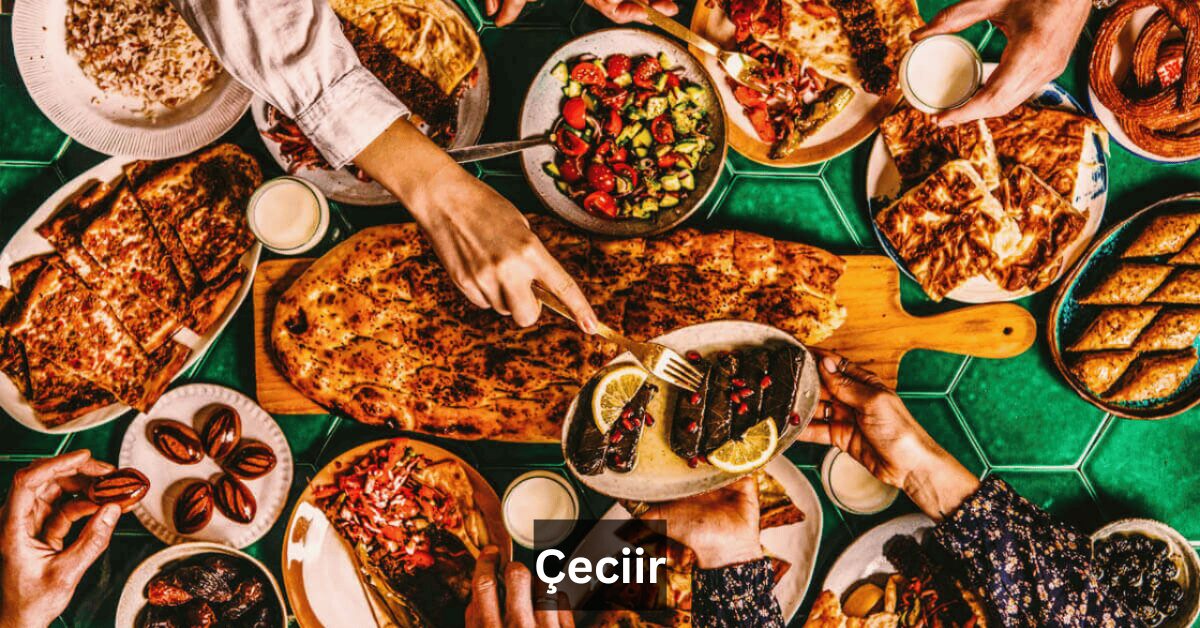Çeciir, a Turkish-Mediterranean gem, celebrates chickpeas (Cicer arietinum, nohut), blending ancient legume heritage with modern taste. Whether served as a crunchy roasted snack or a hearty stew, Çeciir captures the warmth and flavor of traditional Turkish kitchens.
In recent years, Çeciir has begun to shine on the global food scene, not only for its delicious versatility but also for its rich nutritional profile. Packed with protein, fiber, and essential minerals like iron and magnesium, Çeciir is a powerhouse for both body and soul. From family gatherings to street markets, this dish connects generations through flavor and cultural pride. In this detailed guide, we explore the meaning, recipes, and health benefits of Çeciir while unveiling why this ancient food deserves a place in every modern kitchen.
The world is rediscovering legumes, and Çeciir stands proudly among them as a timeless representation of Turkish culinary heritage. As more people embrace plant-based and gluten-free diets, Çeciir has found new life as a protein-rich snack and stew that fits seamlessly into healthy eating trends. From roasted chickpeas enjoyed with tea to stews simmered with olive oil and spices, the dish’s flexibility is unmatched.
What makes Çeciir so loved is its ability to be both simple and luxurious. Whether enjoyed by farmers in Anatolia or served in modern restaurants across Istanbul, Çeciir carries an air of authenticity. Its appeal lies not just in taste but in its story—one of resilience, nourishment, and community.
What Is Çeciir? Meaning and Origin Explained
Çeciir, at its core, means more than just food—it represents a centuries-old relationship between humans and one of nature’s most resilient crops: the chickpea. The term “Çeciir” is thought to have linguistic ties to regional dialects surrounding the word ceci, which means chickpea in Italian, and nohut in Turkish. Over generations, Çeciir evolved into a term that encompasses a range of chickpea-based dishes—from hearty stews to roasted snacks.
In Turkish households, Çeciir often refers to dishes that blend chickpeas with tomato paste, olive oil, cumin, paprika, garlic, and onion. These simple yet aromatic ingredients reflect the essence of Mediterranean cuisine and the culinary wisdom of the Ottoman Empire, where spices and legumes were staples of both royal and rural tables. The blend of earthy chickpeas with fragrant herbs and spices creates a dish that’s as comforting as it is flavorful.
Regional and Cultural Variations of Çeciir
Across Turkey, Çeciir takes on various forms depending on regional preferences. In the Aegean region, it’s often a light, lemony stew served with bread. In Central Anatolia, it becomes a thicker, heartier dish flavored with tomato paste and meat. Meanwhile, coastal areas might serve Çeciir as a cold mezze or side dish with olive oil and herbs. This diversity illustrates how Çeciir has adapted through geography and generations, yet always retained its chickpea essence.
Beyond Turkey, you’ll find similar dishes in Mediterranean cuisine, from Greek revithia to Middle Eastern hummus. These connections highlight how Çeciir is part of a larger culinary story—one rooted in sustainability, health, and shared history.
The Cultural Story Behind Çeciir
Çeciir is not just about flavor—it’s about heritage. Historically, the chickpea (Cicer arietinum) was cultivated in ancient Mesopotamia and quickly became a dietary staple across the Mediterranean basin. Over centuries, the Ottoman Empire carried this ingredient across continents, and Turkish kitchens turned it into a symbol of hospitality and comfort.
In traditional Turkish households, preparing Çeciir is often a communal experience. Families gather to soak chickpeas overnight, boil them slowly, and stir them with care. This process is more than cooking—it’s storytelling through food. Çeciir is often enjoyed during special occasions, symbolizing abundance and togetherness.
The dish’s simplicity is its beauty. It carries the same soul today as it did centuries ago: a dish born from humble origins that nourishes hearts as much as bodies.
Symbolism and Family Customs Connected to Çeciir
In Turkish tradition, Çeciir often appears during winter months and festive gatherings. Sharing a bowl of warm Çeciir stew with neighbors or guests is a gesture of kindness. In rural villages, roasted Çeciir snacks accompany tea during late-night conversations. These customs reflect the Turkish belief that food should connect people.
For many families, Çeciir is a reminder of their roots. It represents resilience—how simple ingredients can create lasting comfort. In a fast-paced world, the act of cooking and sharing Çeciir slows time down and rekindles the values of patience, gratitude, and love.
Types of Çeciir Found Today
Çeciir’s versatility is unmatched, offering countless ways to enjoy it across meals and moods.
Roasted Çeciir (Crunchy Snack Style)
Roasted chickpeas Çeciir is a popular snack throughout Turkey, especially in street markets. Known for its crispy texture and nutty aroma, it’s the perfect tea-time companion. The process involves soaking chickpeas, drying them thoroughly, and roasting them with olive oil, cumin, paprika, and garlic powder until golden. The result is a crunchy, addictive treat packed with protein and fiber—a healthier alternative to chips and processed snacks.
Stewed Çeciir (Nohut Yemeği Style)
The traditional Turkish chickpea stew, or Çeciir nohut yemeği, is a comforting meal made with chickpeas simmered in a rich tomato-based sauce. Olive oil, onion, and garlic form the base, while paprika and cumin infuse the dish with depth and warmth. This Çeciir stew is hearty, satisfying, and deeply aromatic—ideal for pairing with rice or flatbread.
Çeciir Flour Uses in Modern Cooking
Beyond snacks and stews, Çeciir also appears in the form of chickpea flour, known as gram flour or besan. This gluten-free ingredient has become popular in vegan baking, batter recipes, and savory pancakes. Its nutty flavor makes it perfect for health-conscious cooks seeking high-protein alternatives. Gluten-free recipes with Çeciir flour showcase the adaptability of this ancient ingredient in modern diets.
Traditional Çeciir Recipe (Step-by-Step Guide)
Ingredients and Measurements
To make authentic Çeciir, you’ll need:
- 2 cups dried chickpeas (nohut)
- 2 tablespoons olive oil
- 1 medium onion, finely chopped
- 2 cloves garlic, minced
- 2 tablespoons tomato paste
- 1 teaspoon cumin
- 1 teaspoon paprika
- Salt and pepper to taste
Optional: diced lamb or beef for a heartier stew
Preparation and Soaking Method
Start by soaking chickpeas overnight in cold water. This softens their tough outer skin and reduces cooking time. The next day, drain and rinse them well.
In a pot, heat olive oil, then add chopped onions and garlic until fragrant. Stir in tomato paste, cumin, paprika, and salt. Add soaked chickpeas and enough water to cover them. Simmer slowly until tender and creamy.
Serving Suggestions and Presentation Tips
Serve Çeciir hot with rice or flatbread, garnished with parsley and a drizzle of olive oil. For a modern twist, top it with roasted vegetables or a dollop of yogurt. This dish embodies both comfort and elegance—simple ingredients elevated by care and tradition.
Modern Twists on Classic Çeciir Recipes
Modern cooks are reinventing Çeciir with exciting variations that honor tradition while appealing to global tastes.
Oven-Baked and Air-Fried Çeciir Snacks
Air-fried Çeciir has become a sensation for health-conscious snackers. Using minimal oil, you can achieve that signature crunch in under 20 minutes. Try seasoning with chili flakes, garlic powder, or lemon zest for added flair.
Fusion Ideas and Vegan Adaptations
Fusion chefs have begun incorporating Çeciir into salads, grain bowls, and wraps. Vegan versions use chickpeas as the main protein, enhanced with tahini or roasted vegetables. The result? A flavorful, nutrient-dense meal that fits seamlessly into plant-based lifestyles.
Ingredients That Define Authentic Çeciir Flavor
Authentic Çeciir flavor depends on the quality of ingredients and the balance of spices.
Essential Spices and Aromatics
The foundation of Çeciir lies in its use of olive oil, cumin, paprika, tomato paste, garlic, and onion. Each ingredient plays a crucial role: olive oil adds richness, cumin provides earthiness, and paprika offers warmth. The combination creates a fragrant base that defines the essence of Turkish cuisine.
Choosing the Right Chickpeas
For the best results, always use dried chickpeas instead of canned. They hold their shape better during slow cooking and absorb flavors more deeply. However, for quick meals, canned chickpeas work well too. The key is patience—let your Çeciir simmer slowly so every bite tells a story.
Nutritional Value and Health Benefits of Çeciir
Çeciir is more than delicious—it’s incredibly nutritious. Chickpeas are naturally high in protein, dietary fiber, iron, folate, and magnesium, making them a perfect choice for vegan and vegetarian diets. Each serving of Çeciir delivers sustained energy, supports digestion, and promotes heart health.
Because Çeciir is gluten-free and low in fat, it fits beautifully into modern dietary goals. Whether eaten as a high-protein snack or as part of a balanced meal, Çeciir offers nourishment that’s both wholesome and satisfying.
Serving Ideas and Pairings
In Turkish homes, Çeciir is enjoyed in many ways. The roasted version pairs wonderfully with hot tea, while the stew version is served alongside rice or bulgur. It also complements fresh salads, yogurt dips, and flatbreads, creating a complete Mediterranean meal.
For parties, serve small bowls of roasted Çeciir snacks as part of a mezze spread. Their crunch and flavor make them irresistible at any gathering.
How to Store and Preserve Çeciir
Roasted Çeciir should be stored in an airtight container to maintain crunchiness. Keep it in a cool, dry place away from moisture. If it softens, reheat briefly in the oven.
Stewed Çeciir can be refrigerated for up to three days or frozen for longer storage. Reheat slowly over low heat to preserve texture and flavor.
Common Mistakes and Cooking Tips
A few simple tips can ensure perfect Çeciir every time. Avoid over-soaking chickpeas, which can make them mushy. When roasting, dry them completely before seasoning to achieve maximum crispiness. And don’t rush the stew—slow cooking allows spices to fully infuse the chickpeas.
If your Çeciir stew tastes flat, add a splash of lemon juice at the end—it brightens the flavors beautifully.
Çeciir in Modern Culinary Trends
Çeciir is finding new life in today’s culinary landscape. As more people seek sustainable and plant-based foods, chickpeas have become a star ingredient in global kitchens. Çeciir-inspired snacks and ready-to-eat products now line supermarket shelves, offering healthy, protein-packed alternatives to processed foods.
In vegan communities, Çeciir represents balance—traditional flavor meeting modern nutrition. It stands as a reminder that ancient recipes can guide us toward healthier, more sustainable eating.
Conclusion
Çeciir is more than a dish—it’s a story of flavor, history, and nourishment. Rooted in Turkish tradition and embraced by the modern world, it captures the essence of Mediterranean cuisine in its simplest form. From roasted snacks to hearty stews, every version of Çeciir brings people together through the universal language of good food.
In an age where we chase convenience, Çeciir reminds us of the beauty in slowing down—soaking, simmering, tasting, and sharing. It’s food with meaning, culture, and care. And once you taste it, Çeciir becomes not just a recipe, but a ritual worth keeping.
Frequently Asked Questions
What exactly does Çeciir mean?
Çeciir refers to chickpea-based dishes or snacks found in Turkish cuisine, ranging from roasted chickpeas to hearty stews.
Is Çeciir the same as leblebi?
Leblebi is a type of roasted chickpea snack, while Çeciir may also refer to stews or other preparations.
Can Çeciir be made with canned chickpeas?
Yes. Canned chickpeas save time and work perfectly for quick Çeciir recipes.
Is Çeciir gluten-free and vegan?
Absolutely. Chickpeas are naturally gluten-free and plant-based, making Çeciir suitable for vegan diets.
How can I keep roasted Çeciir crispy?
Store them in an airtight container and reheat briefly in the oven to restore crunchiness.



